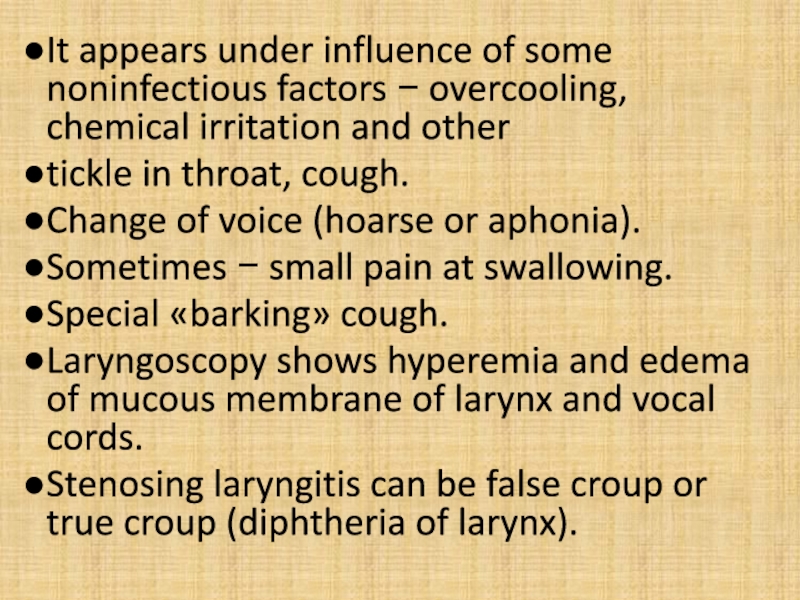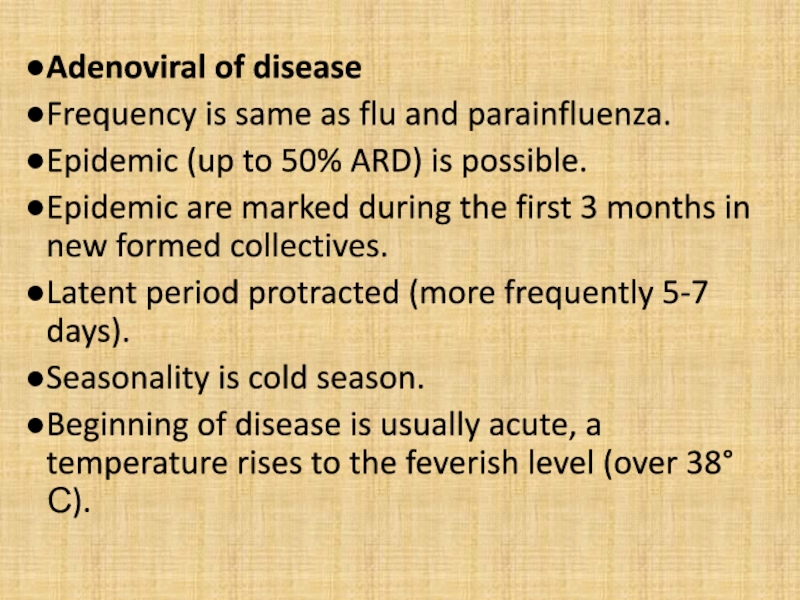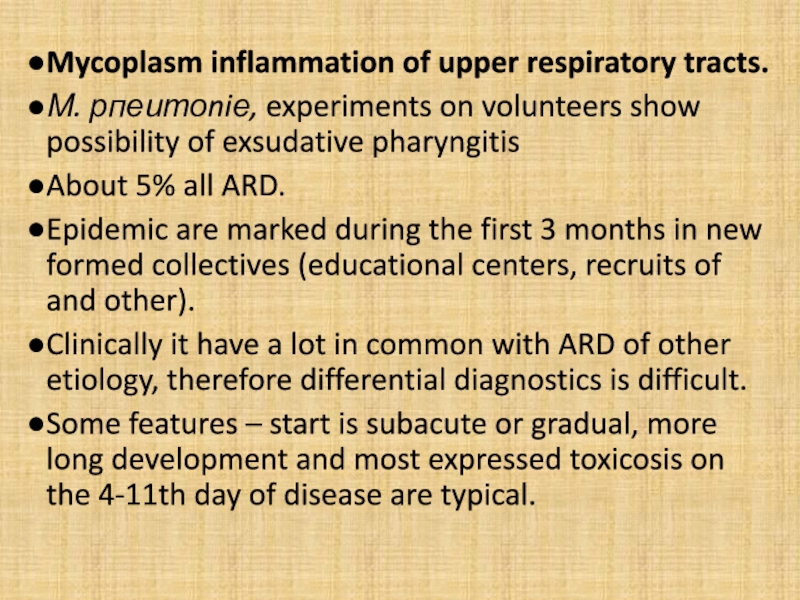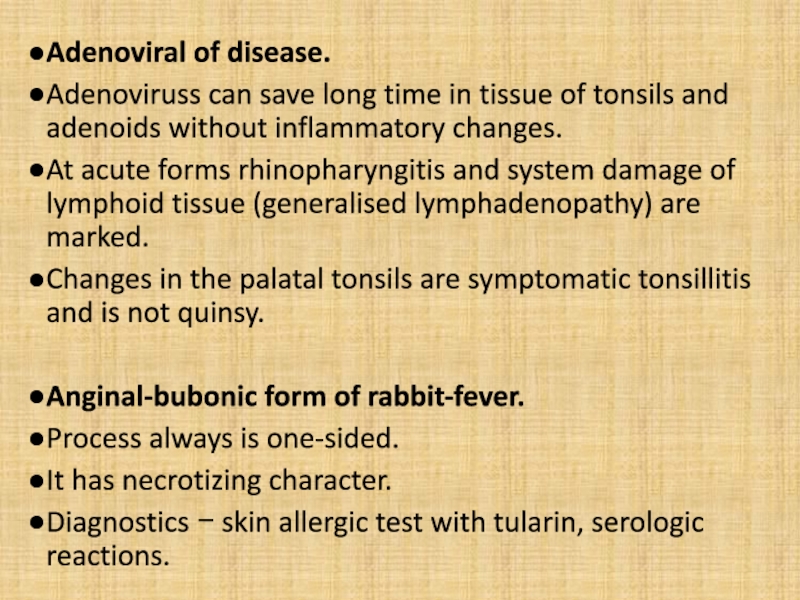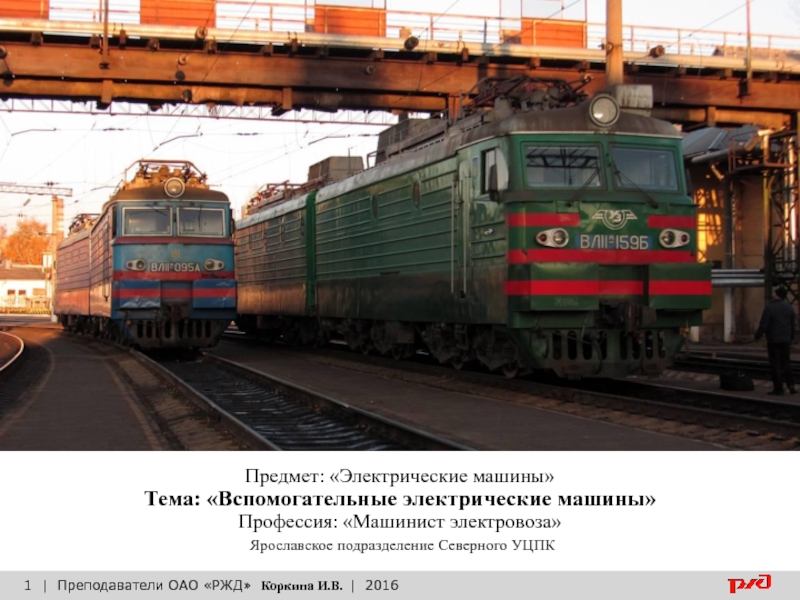Слайд 1SYNDROME OF ACUTE INFLAMMATION OF MUCOUS MEMBRANES of
RESPIRATORY TRACTS
TONSILLITISES
Слайд 2SYNDROME OF ACUTE INFLAMMATION OF MUCOUS MEMBRANES of RESPIRATORY TRACTS
Among
diseases developing with inflammation of upper respiratory tracts (URT), acute
respiratory diseases (ARD) that is characterized by inflammation of mucous membranes of respiratory tracts are most widespread.
On occasion term of ARD is concrete disease, but this nosology form does not exist although. Undifferentiated ARD is syndromal diagnosis and widespread in pediatric practice.
In every case we must set etiology if it is possible, that it is very important for adequate therapy.
Laboratory serologic researches allow to put a correct diagnosis retrospectively.
Слайд 3Term «acute respiratory viral infections» (ARVI) is a group of
viral diseases without concrete nosology.
ARD include not only viral but
also mycoplasm and bacterial diseases.
Consequently, the term «ARD the undifferentiated» includes diagnosis undeciphered etiology during special researches or without it.
ARD are united by:
common way of transmission (respiratory),
primary damage of respiratory tracts.
Слайд 4ARD is most widespread diseases.
Annually over 25% of population
is sick and morbidity rises considerably during epidemic of flu.
Much other infectious diseases without signs of damage of URT are wrongly taken to ARD in practice.
Order of realization of differential diagnostics.
To distinguish damage of respiratory tract.
To decide a question, whether this disease belongs to the group ARD.
Слайд 5To find out etiology.
If etiology is not succeeded a
diagnosis is formulated as «ARD undifferentiated» or ARVI.
To define a
presence, character and intensity of inflammation in the different parts of respiratory tract, primary localization of pathological changes.
The syndrome of inflammation of respiratory tract includes next subsyndromes:
rhinitis,
pharyngitis,
laryngitis,
tracheitis,
bronchitis
it’s different combinations.
Слайд 6Rhinitis is inflammation of mucous membrane of nose.
stuffiness in nose
and by difficult breathing through a nose,
sneezing,
excretion from a
nose (watery or mucous, mucous-purulent, bloody),
the mucous membrane is oedematous, hyperemic, sometimes covered by crusts or fibrinous films.
Pharyngitis is inflammation of mucous membrane of pharynx.
tickle in throat,
moderate pains rarer burning at swallowing,
hyperemia of back wall of pharynx,
edema, grittiness and sometimes hemorrhages of mucous membrane
Слайд 7Character of exudate is mucous, mucous-purulent, purulent.
good light is important.
White films are possible (diphtheria, burning of mucous membrane, candidiasis).
Laryngitis is inflammation of mucous membrane of larynx.
It is frequent component of ARD in combination with inflammation of other parts of URT, rarely − isolated.
It pesents at infectious diseases (flu, parainfluenza, adenoviral diseases, measles, whooping-cough and other)
Слайд 8It appears under influence of some noninfectious factors − overcooling,
chemical irritation and other
tickle in throat, cough.
Change of voice
(hoarse or aphonia).
Sometimes − small pain at swallowing.
Special «barking» cough.
Laryngoscopy shows hyperemia and edema of mucous membrane of larynx and vocal cords.
Stenosing laryngitis can be false croup or true croup (diphtheria of larynx).
Слайд 94 degrees of stenosis :
I − short breathing difficulty,
no respiratory insufficiency;
II − attacks of breathing difficulty are
frequent, indrawing of areas of thorax (jugular fossa, supra- and subclavicular space, epigastric area), noisy breathing, moderate respiratory insufficiency.
III − II + cyanosys of lips, extremities, uneasiness of patient, acutely expressed respiratory insufficiency.
IV − asphyxia.
Stenosing laryngitis is observed mainly at children.
Слайд 10Chronic laryngitis at noninfectious pathology − hoarseness and rapid fatigueability
of voice, tickle in throat, dryness.
Tracheitis.
dyscomfort behind breastbone,
objectively − at fibrobronchoscopia.
Bronchitis and bronchiolitis.
Слайд 11As a component of ARVI if it combines with the
damage of URT.
For ARD an acute bronchitis is characteristic
only.
Exacerbation of chronic bronchitis is not ARD.
At ARD a bronchitis combines with the manifestations of inflammation of URT.
At some ARD (RS-virus) symptoms of bronchitis are on the first plan.
Clinical manifestations of acute bronchitis are cough in the beginning usually dry, mucous or mucopurulent sputum, general intoxication; objectively: dry or moist rales.
Disorders of bronchial passableness manifest by lengthening of exhalation.
Слайд 12A bronchiolitis is more severe form of acute bronchitis.
Bronchioles are
involved in a process.
The signs of general intoxication and
disorder of bronchial passableness are more expressed: breathlessness, development of obstructive emphysema, respiratory insufficiency, painful cough with a scanty sputum.
For differential diagnostics of syndrome of acute inflammation of respiratory tracts it is very important to educe carefully a prevalence of inflammatory changes in one or another part.
Слайд 13Next groups of diseases with inflammatory changes of upper respiratory
tracts are possible:
ARD;
inflammation of respiratory tracts as sign of other
infectious disease;
inflammation of respiratory tracts as a result of chemical influence;
exacerbation of chronic inflammatory diseases of respiratory tracts (chronic rhinitis, nasal asthma, chronic laryngitis, chronic bronchitis of and other).
For an infectiologist first two groups of diseases have main practical value.
Слайд 14Acute respiratory diseases:
adenoviral diseasees;
bacterial nasopharyngitis (streptococcus, staphylococcus and other);
herpetic respiratory
diseasees;
flu;
coronaviral respiratory diseasees;
meningococcal nasopharyngitis;
Слайд 15respiratory syncytial infection (RS-virus disease);
rhinovirus disease;
enterovirus nasopharyngitis;
mycoplasm inflammation of upper
respiratory tracts;
parainfluenza;
other ARD (undifferentiated).
Слайд 16Infectious diseases developing with the signs of inflammation of respiratory
tracts:
herpangina;
diphtheria;
whooping-cough (pertussis);
measles;
rubella;
Q-fever;
chickenpox;
smallpox;
paratyphoid A;
anthrax (pulmonary form);
Слайд 17Toxicochemical inflammatory changes of URT :
develops without the expressed fever
and signs of general intoxication;
possibility of poisoning (breathing in steams
and toxic gases);
professional character of disease;
short latent period.
Exacerbation of chronic inflammatory changes of respiratory tracts :
ARD can imitate it sometimes;
it is necessary to study anamnesis carefully;
more protracted development is characteristic.
Main task of differential diagnostics of the diseasees of the first group is to try to detect nosology (clinical, epidemiology and laboratory data).
Слайд 18Flu. A diagnosis is not difficult during epidemics.
At the beginning
of epidemic flu develops more heavily with typical clinical manifestations
and at the end of epidemic mild forms begin to prevail.
The acute start: temperature of body with a chill at the first day arrives at a maximal level (39-40 °С).
A headache is acutely expressed with localization in a frontal area, superciliary arcs, in eyeballs.
Lacrimation and photophobia.
Pains in muscles and joints.
Слайд 19General intoxication is expressed (meningism, encephalopathy ).
Hypotension.
85% cases last
3-5 days.
The presence of the expressed tracheitis is characteristic.
rhinitis, pharyngitis,
laryngitis are possible.
Laboratory confirmation: PCR, IHT, Immunofluorescence.
Слайд 20Parainfluenza
Unlike a flu does not have such clear clinical
presentation.
There are not large epidemics.
Latent period 3-6 days.
20%
of all ARD at adults and 30% at children arecaused by viruses of parainfluenza.
Seasonality is cold period of year with an increase at the end of winter and at the beginning of spring.
It usually begins gradually, maximal expressed clinical symptomatology arrives in 2-3 days.
Слайд 21The temperature of body, as a rule, is subfebrile.
The symptoms
of general intoxication are expressed poorly.
Rhinitis, pharyngitis and especially laryngitis
are typical. Inflammatory changes are most expressed in a larynx at children (false croup).
A tracheobronchitis develops rarely.
Complication pneumonia arise up rarer than at flu.
Conjunctivitis at 50% of patients.
Diagnostics: immunofluorescent method, PCR, IHR.
Слайд 22Adenoviral of disease
Frequency is same as flu and parainfluenza.
Epidemic (up
to 50% ARD) is possible.
Epidemic are marked during the first
3 months in new formed collectives.
Latent period protracted (more frequently 5-7 days).
Seasonality is cold season.
Beginning of disease is usually acute, a temperature rises to the feverish level (over 38°С).
Слайд 23Duration of temperature is saved more protractedly (to 10-20 days).
General condition is moderate, high fever, general intoxication are expressed
weaker than at flu.
Part of patients has a twowave temperature curve (even in default of complications).
At adults disease usually develops in mild form.
Mainly rhinopharyngitis, sometimes is laryngitis (at children) are typical.
The most frequent form is pharingoconjunctival.
Increase of peripheral lymphonoduses, conjunctivitis (more frequent follicle).
Stomach-aches, diarrhea are possible.
Слайд 24Pneumonias develop rarely.
Diagnostics - immunofluorescent method, PCR, IHT.
Respiratory syncytial infection.
It
meets mainly at children (30-70% bronchitis and bronchiolitiss and 10-30%
acute pneumonias).
At adults sporadic cases develop relatively easily but are frequently (about 25%) complicated by pneumonias at elderly.
A characteristic feature is a rapid damage of bronchial tubes and bronchioles, other parts of URT are damaged mildly.
Слайд 25Development is more protracted than at other ARD.
Diagnostics - immunofluorescent
method, PCR, IHT.
Rhinovirus disease.
Absence or poorly expressed general intoxication
and expressed rhinitis with rhinorrhea are typical.
Complications from the side of ENT-organs only.
Diagnostics - immunofluorescent method, PCR, IHR.
Слайд 26Enterovirus (EVI) nasopharyngitis.
Among the different manifestations of EVI it
can develop as rhinopharyngitis.
General intoxication and signs of inflammation of
URT.
The inflammatory changes of mucous membranes of respiratory tracts show up at most patients as rhinitis or rhinopharyngitis.
20% − hyperemia of conjunctiva.
Rarely − laryngitis.
A tracheitis and bronchitis do not almost develop.
A peak of morbidity is on the end of summer and beginning of autumn.
Along with the typical manifestations of ARD other clinical forms are marked: epidemic myalgia, enterovirus exanthema, herpangina and other
Слайд 27These manifestations are original indicators of EVI. Sporadic cases is
difficult to recognize clinically.
Diagnostics - immunofluorescent method, PCR, IHT,
ELISA.
Herpetic respiratory diseases.
HSV-1 causes from 5 till 7% all ARD.
Children are ill mainly.
Signs of inflammation of URT are present at a primary infection; in future virus is saved as a latent infection and at relapse skin damages appear.
It develops as usual pharyngitis.
Intoxication is expressed poorly.
Diagnostics - immunofluorescent method, PCR, IHT, ELISA.
A herpetic rash does not have a substantial differential diagnostic value.
Слайд 28Mycoplasm inflammation of upper respiratory tracts.
М. рпеитоniе, experiments on
volunteers show possibility of exsudative pharyngitis
About 5% all ARD.
Epidemic
are marked during the first 3 months in new formed collectives (educational centers, recruits of and other).
Clinically it have a lot in common with ARD of other etiology, therefore differential diagnostics is difficult.
Some features – start is subacute or gradual, more long development and most expressed toxicosis on the 4-11th day of disease are typical.
Слайд 29Bacterial ARD.
Streptococci, staphylococci and other cause isolated damages of
some part of URT.
Antibiotic therapy is very effective.
Severe
generalised forms can develop after meningococcal nasopharyngitis and rhinitisatism, myocarditis, nephritis and other - after streptococcal pharyngitis.
Слайд 30Streptococcal pharyngitis.
Вeta-haemolytic streptococcustococcus group А is characteristic for pharyngitis
and other streptococcus diseases (scarlatina, quinsies, erysipelas).
In a acute
period bright hyperemia of pharynx, soft palate, amygdales presents. Mildly expressed rhinitis, laryngitis, hemorrhages and oedema can appear.
Antibiotic therapy already results by normalization of temperature and reduction of general intoxication during 24 hours and during 72 hours- by changes in pharynx. CBC − moderate leucocytosis
Слайд 31Meningococcal nasopharyngitis (rhinopharyngitis).
Inflammation of mucous membrane of nose and pharynx.
At some patients the signs of meningitis or meningococcemia can
appear in a few days.
It is very important to recognize disease and begin therapy to avoid development of generalised forms in good time (expresstests and microscopy).
It has a lot of common with viral nasopharyngitis.
General weakness, a moderate headache, stuffiness in a nose, excretions from a nose (from the beginning mucous-purulent, quickly become purulent, sometimes with the admixture of blood) are typical.
Cough and moderate pains at swallowing can appear.
Слайд 32The temperature is normal (40%) or subfebrile.
Edema and hyperemia
of mucous membrane of epipharynx, mucous-purulent exudation.
CBC − small
neutrophilic leucocytosis.
Penicillins quickly result in the improvement of the general state.
Etiologic diagnosis is bacteriologicexamination of mucus from epipharynx before use of antibiotics.
It is necessary to take into account epidemiology data (cases in a collective).
There are no laryngitises, tracheitiss, bronchitis, but specific meningococcal pneumonias are possible.
Слайд 33INFLAMMATION of MUCOUS MEMBRANES of RESPIRATORY TRACTS AT the DISEASEES
not INCLUDED In GROUP of ACUTE RESPIRATORY DISEASES – one
of other manifestations of disease.
Diphtheria of nose.
It is manifested by ichor excretions from nose with maceration of skin around and upper lip.
Hyperemia, bulge of mucous membrane, fibrinous tapes with bleeding after removing of it.
Usually it combine with diphtheria of pharynx(widespread diphtheria).
A diagnosis must be necessarily confirmed by bacteriologicexamination.
Слайд 34Whooping-cough and parapertussis.
These diseases are differentiated only bacteriologically.
Initial
period – catarrhal (rhinitis and laryngotracheitis).
Common state is satisfactory, temperature
is usually normal or subfebrile.
Rhinitis and cough in the beginning are small, increase later, typical fits of the convulsive coughing appear only at the end of 2th week.
Later − signs of bronchitis.
For diagnostics epidemiology data are important (absence of vaccination, contact with a patient).
Specific diagnostics − bacteriologicexamination or serologic.
Слайд 35Measles.
Before appearance of characteristic exanthema it is frequently interpreted
as ARD.
Fever, pharyngitis.
Expressed conjunctivitis with bright hyperemia.
Filatov-Koplik
spots on the mucous membrane of mouth.
Typical morbillous exanthema appears on the 4th day.
Слайд 36Rubella.
Signs of acute rhinopharyngitis, small hyperemia of conjunctiva, subfebrile
temperature of body are possible at atypical rubella (without an
exanthema).
Moderate increase of neck lymphatic nodes (similar at a parainfluenza and adenoviral disease).
Growth of titles of antibodies in 4 times and more confirms rubella.
Atypical rubella takes 25-30% of all cases.
It is especially important at pregnancy.
Diagnostics - IHT, ELISA.
Слайд 37Herpangina.
Pharyngitis, intoxication.
Enanthema: hyperemia − small red spots (2-3 mm)
- vesiculas (4-5 mm) - aphthae (to 5-7 mm).
Total about
20 elements of enanthema develop one week and disappear without trace.
Diagnostics bases on only clinical data.
Слайд 38Q-Fever.
Bronchial tubes are damaged mainly, but moderate inflammation of
upper respiratory tracts as pharyngitis and laryngitis with the expressed
intoxication are marked.
Hyperemia of face, neck, injection of vessels of sclera like at flu.
Seasonality is summer-autum while ARD meet rarely.
Increase of liver and spleen appearss fom 3-4th day (not characteristically for the flu and other ARD).
Diagnostics − CFR with an antigen of Rickettsia Burnetti.
Слайд 39Chicken-pox.
Pharyngitis, laryngitis, sometimes specific viral pneumonia can develop.
A
diagnosis is not difficult due to typical polymorphic vesicular rash.
Paratyphoid
А.
There are rhinopharyngitis, tracheobronchitis, conjunctivitis at initial period.
It develops more gradually with growth of fever.
Intoxication fall short of to the inflammatory changes of respiratory tracts.
Слайд 40Diagnostics is bacteriological and serologic.
Anthrax (pulmonary form).
Acutely expressed rhinitis,
pharyngitis, laryngotracheitis, bronchitis and conjunctivitis.
Symptoms of hemorragic pneumonia, quickly developing
shock.
Diagnostics is bacteriologic, bacterioscopic and serologic.
Слайд 41TONSILLITISES (inflammation of palatal tonsils).
Tonsillitis can be manifestation of quinsy
or one of signs of other infectious disease.
Quinsy (acute
bscterial tonsillitis) − inflammation of palatal tonsils and regional lymphatic nodes is basic manifestation of disease.
Tonsillitis is inflammation of tonsils at other infectious and noninfectious diseases as one of signs of these diseasees.
Chronic tonsillitis − is the chronic inflammation of palatal tonsils and regional lymphatic nodes, quite frequent with development of manifestations of chronic general intoxication and specific complications.
Слайд 42For diagnostic of tonsillitis it is necessary to observe certain
rules:
Good illumination at examination for correct perception of color.
Medical
careful examination of fauces (by means of two spatulas).
Sizes, color, relief and state of palatal handles, soft palate, tongue, back wall of pharynx are estimated.
Presence of mucus, pus, fibrinous films is marked
Слайд 43Quinsy.
It can be caused by haemolytic streptococcus (85%), staphylococcus aureus
(10%), fusobacteria (necrotic Vincent's quinsy).
Clinically the expressed intoxication corresponding to
the inflammatory changes of palatal tonsils, pain at swallowing present.
Diagnostics is bacteriological.
Слайд 44Features of necrotic Vincent's quinsy:
absence of the expressed symptoms
of general intoxication,
pharyngalgia at swallowing is not present or
expressed poorly,
process is usually one-sided, in the first twenty-four hours moderate hyperemia, after the rounded greyish-white spot (about 10 mm), from the 2-3th day greyish film, at the removal of that defect (ulcer) is marked, from a 4-5th day ulcer is crateriform
putrid smell from mouth,
confirmation — bacterioscopy.
Слайд 45Infectious:
adenoviral diseases;
anginal-bubonic form of rabbit-fever;
anginal-septic form of listeriosis;
diphtheria of pharynx;
infectious
mononucleosis;
candidiasis of fauces;
parainfluenza, flu and other ARD;
syphilis;
scarlatina;
paratyphoid.
The group of symptomatic
tonsillitises includes a number of diseasees of infectious and noninfectious nature :
Слайд 46Noninfectious:
agranulocytosis
radiation disease;
acute leucosises;
cytostatic disease;
chronic tonsillitis.
Слайд 47Adenoviral of disease.
Adenoviruss can save long time in tissue
of tonsils and adenoids without inflammatory changes.
At acute forms rhinopharyngitis
and system damage of lymphoid tissue (generalised lymphadenopathy) are marked.
Changes in the palatal tonsils are symptomatic tonsillitis and is not quinsy.
Anginal-bubonic form of rabbit-fever.
Process always is one-sided.
It has necrotizing character.
Diagnostics − skin allergic test with tularin, serologic reactions.
Слайд 48Film on the tonsil has greyish color and deep ulcer
appears after sloughing.
After repairing of ulcer scars on an
tonsil appear.
Unlike necrotic Vincent's quinsy high fever and intoxication are typical.
A characteristic feature is formation of bubo (upper and anterior neck)
A bubo is not soldered with surrounding tissues, movable, a skin above it is not changed, fluctuation and fistula usually appear at the end of 3th week from the beginning of illness.
A feverish period proceeds 10-15 days, but cicatrization of ulcer on an tonsil and reverse development of bubo take place considerably slower.
Слайд 49Anginal-septic form of listeriosis.
Tonsillitis develops on a background a severe
general (septic) disease with the varied clinical manifestations.
Quite frequent
rash (erythema with the figure of «butterfly» on face).
Generalised lymphadenopathy, constantly − hepatosplenomegaly, and at some cases purulent meningitis.
Clinical diagnosis is difficult.
Слайд 50Diagnostics − bacteriologic (from blood, neurolymph, pharynx), serologic (CFR and
IHR).
A listerious allergen is produced for skin test −
passing of negative to positive.
Diphtheria of pharynx.
Damage of palatal tonsils is obligatory.
Differential diagnostics is especially laboured at development of streptococcus quinsy at the bacillicarrier of toxigenic C.diphtheriae.
The catarrhal form of diphtheria of pharynx is differentiated with a catarrhal quinsy; island-like − with lacunar, membranous − with a necrotizing quinsy, and toxic – with quinsy complicated by abscess.
Diagnostics − bacteriologic examination (toxigenic C.diphtheriae), serologic, bacterioscopy.
Слайд 51Catarrhal form of diphtheria of pharynx.
Atypical form, without fibrinous
films on tonsils.
The temperature of body is normal or
subfebrile.
A pharyngalgia at swallowing is absent or expressed poorly.
The mucous membrane of tonsils is mildly hyperemic and on the 2-3th day small edema and cyanochroic colouring is possible.
It can pass to membranous in future.
Specific characteristic complications are possible.
Слайд 52Island-like form of diphtheria of pharynx.
The small areas of fibrinousого
film (small «islands») on tonsils are easily taken off by
a spatula, thin.
Lacunar quinsy develops with a high fever, expressed symptoms of general intoxication, great pains in a throat.
Island-like a form develops with subfebrileой temperature of body, pains at swallowing are absent or expressed poorly.
Without specific treatment illness passes to the membranous form.
Слайд 53Membranous diphtheria of pharynx.
Expressed continuous fibrinous films keeping indoors outside
tonsils.
A film is taken off hardly, in place of it
bleeding surface appears. The taken off film sinks in water.
Intoxication is expressed and does not correlate with the temperature of body.
High probability of specific complications characteristic for diphtheria.
Widespread diphtheria of pharynx.
fibrinous film goes across and on the surrounding areas of mucous membrane − back wall of pharynx, soft palate, uvula.
Слайд 54Toxic diphtheria is characterized by appearance of edema of neck
cellular tissue.
At toxic diphtheria false diagnose of quinsy complicated by
abscess is possible.
The expressed pharyngalgia is not present (diphtherin has anaesthetic action).
Grey-brown films can cover both palatal tonsils and surrounding tissues.
Edema on a neck, high fever, expressed symptoms of intoxication are typical.
Слайд 55Appearance of paratonsillar abscess is characterized by a rapid fervescence,
chill expressed by a toxicosis.
Trismus of masticatory musculature limits
opening of mouth.
One-sided edema and infiltration are marked in default of films on the mucous membrane of tonsils.
The diagnosis of diphtheria is confirmed by the selection of causative agent.
Infectious mononucleosis.
Almost always develops with the damage of pharynx.
Acute beginning, high fever, intoxication.
Слайд 56 Appearance of tonsillitis is possible after ferver, general intoxication
and other signs of mononucleosis.
It can imitate lacunar quinsy,
necrotizing changes of tonsils and even fibrinous films.
A fever and toxicosis are saved protractedly, and changes in a pharynx do not grow and keep indoors outside tonsils.
Generalised lymphadenopathy appears early (from the first days of illness).
Hepatosplenomegaly appears at the 3-5th day, a spleen ise considerably increased and painful at palpation.
Слайд 57Acute hepatitis can develop.
CBC − leucocytosis, neutropenia, lymphomonocytosis, atypical mononuclears.
The changes of blood appear early and saved long time
(sometimes few months).
Diagnostics is an serologic, PCR.
Слайд 58 Candidiasis of fauces.
Arises up as a result of dysbacteriosis
and immunodeficit.
The temperature of body remains normal, rarer subfebrile.
Film
related to the mycosis, greyish-white color, usually by separate areas, not only at tonsils but also mucous membrane of cavity of mouth, back walls of pharynx.
Слайд 59Inflammation of tonsils is not actual it is not tonsillitis
but widespread candida damage of mucous membrane of fauces.
Diagnostics
is mycologic research.
Flu, parainfluenza and other ARD – cataral tonsillitis is included in clinic of inflammation of respiratory tracts.
Syphilis.
At the primary syphilis original primary syphiloma at gate of infection.
Increase of one tonsils, mucous membrane is hyperemic.
Слайд 60A regional lymphatic node is mildly increased, dense consistency, painless.
Pains at swallowing is not marked.
General condition is normal.
Small erosion on tonsils (5-10 mm is in a diameter) with clear dense edges and clean bottom.
Abundant exanthema and/or enanthema present at second stage of disease.
A diagnosis is confirmed by specific laboratory methods.
Слайд 61Scarlatina
Like quinsy it is caused by haemolytic streptococcustococcus group
A.
Along with a clinic signs of quinsy, influence of erythrogenic
toxin manifests by skin hyperemia, rash with, tachycardia.
Unusually bright hyperemia of mucous membrane is a «blazing pharynx».
Clean hyperemic language with increased papillae («raspberry language»).
Laboratory confirmation of diagnosis is absent.
Слайд 62Typhoid fever.
Palatal tonsils and archs are edematous, small ulcers
covered by a greyish films are possible.
Other manifestations of main
disease have prevalence.
Diagnostics is bacteriological, serologic.
Noninfectious illnesses.
Tonsillitis presents at haematological diseases (different forms of leucosises), neutropenia (acute radiation illness, immune agranulocytosis and other), changes of tonsils have necrotizing character.
Слайд 63Chronic tonsillitis.
Character of development is decompensated and subcompensated.
Periodic exacerbation
and remissions are typical.
Exacerbation is provoked by supercooling or
ARD.
In remission signs of chronic toxicosis (general weakness, fatigueability, irritability, subfebrile fever), vasoneurosis (lability of pulse, orthostatic hypotension, dyscomfort in heart area) present.
Chemical burns can also cause the inflammatory changes of mucous membrane of tonsils, sometimes with formation of films and do not cause diagnostic difficulties.







